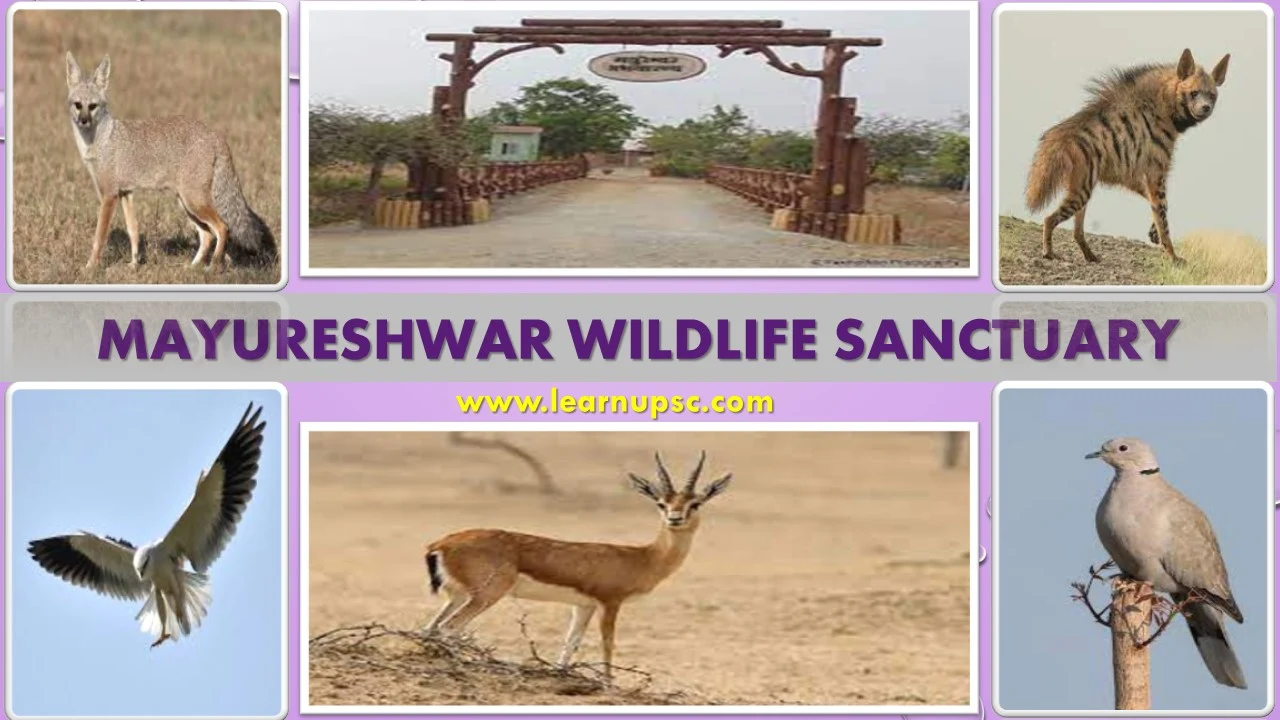Mayureshwar Wildlife Sanctuary UPSC
The Mayureshwar Wildlife Sanctuary is located in the state of Maharashtra, India. The sanctuary is famous for its status as a birdwatching location, with bird enthusiasts drawn to the diverse avian species that inhabit the area.
The Mayureshwar Wildlife Sanctuary serves as a hub for both conservation and ecotourism, offering a glimpse into the natural beauty and biodiversity of the region's dry deciduous scrub forest ecosystem. It provides a valuable opportunity for visitors to connect with nature and observe various plant and animal species in their natural habitat.
|
Table of Contents
|
Mayureshwar Wildlife Sanctuary Location
The Mayureshwar Wildlife Sanctuary is located in Tehsil Baramati in the Pune district of Maharashtra, India. It is situated approximately 74 kilometers from Pune and about 35 kilometers from Daund.
Mayureshwar Wildlife Sanctuary Nearest Airport:
The nearest airport to the Mayureshwar Wildlife Sanctuary is Pune Airport (Lohegaon Airport), which is located about 72 kilometers away.
Mayureshwar Wildlife Sanctuary Nearest Railway Station:
The nearest railway station to the sanctuary is Daund Junction, located approximately 35 kilometers away.
Mayureshwar Wildlife Sanctuary History
Establishment as a Sanctuary: The Mayureshwar Wildlife Sanctuary was officially designated as a sanctuary on August 19, 1997. This marked a significant step in recognizing the ecological importance of the region and establishing it as a protected area for biodiversity conservation.
Mayureshwar Wildlife Sanctuary Area
The Mayureshwar Wildlife Sanctuary covers an area of approximately 5.14 square kilometers. This relatively compact size allows for easy exploration and observation of the sanctuary's diverse plant and animal life.
Despite its relatively small area, the sanctuary is home to a variety of flora and fauna, making it an interesting destination for nature enthusiasts, especially those interested in birdwatching due to the avian diversity present in the region.
Mayureshwar Wildlife Sanctuary Flora
The Mayureshwar Wildlife Sanctuary is known for its distinctive flora, which is adapted to the dry deciduous scrub forest and grassland ecosystem of the region.
Here are some of the plant species that can be found within the sanctuary:
- Khair (Acacia catechu)
- Hivar (Ficus benghalensis)
- Sisoo (Dalbergia sissoo)
- Ber (Ziziphus mauritiana)
- Karwand (Carissa carandas)
- Alysicarpus bupleurifolius
- Cyathocline purpurea
- Eriocaulon diane
- Merremia emarginata
- Cucumis melo
- Cyperus kyllingia
- Striga densiflora
- Mareilea minuta
Mayureshwar Wildlife Sanctuary Fauna (Mayureshwar Wildlife Sanctuary Animals)
What animals are in Mayureshwar Wildlife Sanctuary?
Mammals:
- Chinkara
- Striped Hyaena
- Wolf
- Indian Fox
Birds:
- Indian Roller
- Black-winged Kite
- Eurasian Collared Dove
- Ashy-crowned Sparrow Lark
- Blue-cheeked Bee-eater
- Gray Francolin
- Yellow-wattled Lapwing
- Common Hawk-cuckoo
- Shorttoed
- Snake Eagle
- Bonelli’s Eagle
- Rufous-Fronted Prinia
- Indian Bush-Lark
- Bay-Backed Shrike
- Southern Gray Shrike
- European Roller
- Montagu's Harrier
Reptiles:
- Python
Mayureshwar Wildlife Sanctuary UPSC Questions
Q. What is Mayureshwar Wildlife Sanctuary famous for?
A. The Mayureshwar Wildlife Sanctuary is primarily famous for being a notable birdwatching destination and for its role in conserving a unique dry deciduous scrub forest and grassland ecosystem. Here are the key aspects for which the sanctuary is renowned:
1. Birdwatching: The sanctuary is a popular hotspot for birdwatching enthusiasts. Its diverse habitat, including dry deciduous scrub forest and grasslands, attracts a wide variety of avian species. Birdwatchers can observe and appreciate a range of birds, from colorful and striking species to those with unique behaviors.
2. Avian Diversity: The sanctuary is home to a rich variety of bird species, including Indian Roller, Black-winged Kite, Ashy-crowned Sparrow Lark, Blue-cheeked Bee-eater, Gray Francolin, Yellow-wattled Lapwing, and many others. This diversity of birdlife contributes to its reputation as a significant location for bird enthusiasts.
3. Wildlife Conservation: The Mayureshwar Wildlife Sanctuary plays a crucial role in conserving the biodiversity of its unique habitat. By designating it as a protected area, efforts are made to prevent habitat destruction and ensure the survival of various plant and animal species, some of which might be endemic or threatened.
4. Natural Beauty: The sanctuary's landscape, comprised of dry deciduous scrub forest and grasslands, offers visitors a chance to experience and appreciate the natural beauty of the region. The diverse flora and fauna, combined with the serene surroundings, contribute to a fulfilling nature experience.
5. Accessibility: Due to its proximity to Pune and Daund, the Mayureshwar Wildlife Sanctuary is easily accessible, making it a convenient destination for people interested in experiencing nature without traveling far from urban areas.
6. Trails and Watchtowers: The sanctuary's management has established trails and watchtowers to facilitate visitors' exploration and wildlife observation. These features enhance the overall experience by providing opportunities to see and learn about the wildlife while minimizing disturbance to their habitats.


No comments:
Post a Comment